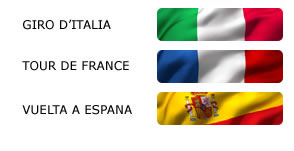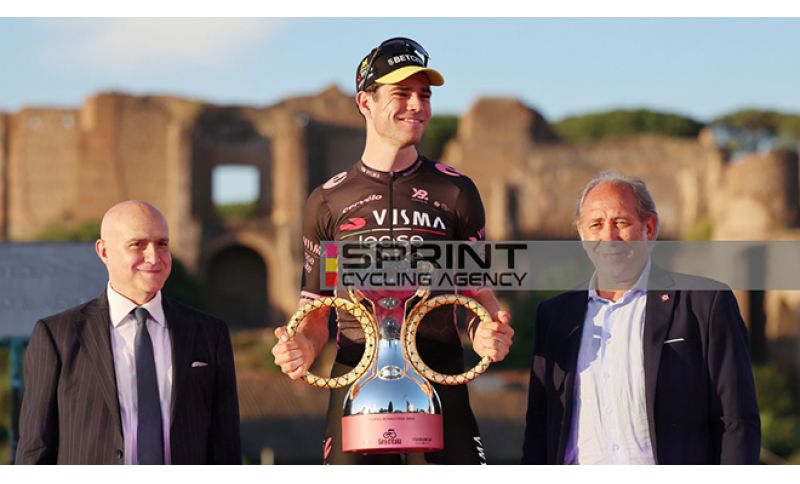

The last two days of the Giro d'Italia for Visma-Lease a Bike were incredible. On Saturday, Simon Yates turned the general classification upside down and took the pink jersey from Isaac del Toro, and the next day Olav Kooij sprinted to victory in the final stage in Rome. Important days that show how beautiful and unpredictable cycling can be: in all the moments when the yellow-black team triumphed, Wout van Aert was present. The Flemish rider missed his main objective: winning the first stage and wearing the pink jersey, but in Siena he was reborn by winning on the gravel of Strade Bianche and then climbed uphill and descended to bring Yates and Kooij to success.
"It's hard to describe what we experienced in this Giro," Van Aert said in Rome. "We showed that we can do a lot and win because as a team, when we are united, we can be the strongest."
During the last mountain stage, Wout van Aert was crucial in guiding Simon Yates to the finish, drawing what are called the perfect curves on the descent. In Kooij's victory in Rome, for the final stage, Edoardo Affini led the sprint for most of the way, but it was Van Aert who gave a final push before the Dutchman could launch like a rocket down Via del Circo Massimo.
"He's like a truck. When he gains speed, he doesn't stop and no one can overtake him," the Flemish rider commented about Kooij. "It was fantastic to enter that last curve, it was a perfect finale."
Few expected Simon Yates to win the Giro, but Van Aert and the team knew the Briton had the right qualities to do so, but they also knew that first and foremost, he had to believe in his potential and have confidence. "It's very special and hard to describe. Actually, we didn't even expect it ourselves, and this memory will certainly remain etched in all of our minds."
Van Aert didn't win the first stage or wear the pink jersey, but he still received an important recognition in Rome. The Belgian won the Trofeo Bonacossa, awarded by a jury of journalists for the "greatest sporting feat" of the Giro. Van Aert truly made his mark because his Visma-Lease a Bike in 2024 had gone through difficult moments, and the Belgian had not obtained any significant victories in what was supposed to be his renaissance spring. Then came the Giro opportunity, but initially, victory did not arrive, and that second place in Tirana seemed like a true punishment for him. Redemption came for him in the ninth stage in Siena, where he proved to be the strongest in those difficult stages like a spring Classic.
"I still need to process it a bit. I am very proud of this team, of what we have done in the last three weeks. And then this victory of Olav Kooij in the final stage was truly incredible, a perfect finale."
Rewinding the tape and going back to Saturday, what Wout van Aert pulled out of his legs on the road to Sestriere was impressive. In those sixteen total kilometers, thanks to the Belgian, Yates increased his advantage by three minutes and six seconds over the pink jersey of Del Toro. That driving force of Van Aert undoubtedly contributed to giving that advantage that decided the Giro. The tactic used by the Dutch team was the same as Hautacam at the 2022 Tour, when Van Aert in the green jersey was sent to the front to work and pulled so hard on the final climb that even Tadej Pogacar was forced to surrender.
The Sestriere data was published by Van Aert on Strava and shows how far his work went. After 197.8 kilometers of racing, six kilometers from the finish, the Flemish rider's speed drops from an average of forty kilometers per hour to just five kilometers per hour, because his work was now finished and Yates had the pink jersey on his shoulders.
The power data was not published by Van Aert, and therefore the calculations made by Belgian analysts are on Simon Yates. The Briton, who weighs 58 kilos, produced 335 watts to stay on Van Aert's wheel. In conclusion: Yates certainly owes his Giro victory to Van Aert, but it must be said that the Briton had made the fastest climb ever on the Colle delle Finestre and with a time of 59'18" was the first rider ever to cover the 18.24 kilometers of climb at 9.4% in less than an hour. In short, the two from Visma-Lease a Bike were the perfect couple, while behind them, Del Toro and Carapaz had inflicted their own ruin. "I think it was worth it," the Belgian continued after the ritual photos in Rome. "When I think about the Finestre, I can say that it was a climb we hadn't yet faced in this Giro. It required a long effort. Our plan was clear, and the fact that I was in the breakaway and could drop Simon gave us the opportunity to continue further. Everything worked perfectly. I don't even know how I survived that climb. Halfway through, I knew we could do it, but it was the most difficult moment of the day and perhaps even of the Giro. But this finale was perfect."
One of the architects of the winning tactic is sports director Marc Reef, who explained how Van Aert's role was fundamental in bringing Yates to victory. "Without Wout, it would have been more difficult. We had a plan ready with Wout in the breakaway, and we knew there were excellent possibilities on the Colle delle Finestre. If Wout overcame that climb, then our weapon would work, and so it was. Without him, it would have been more difficult for Simon. Wout made the difference towards the last climb in terms of time differences. Three kilometers from the top, we knew he would make it, and then once Yates caught up with him, we knew everything would be fine. Wout is that man in the team who can solve the race and bring teammates to victory through his generosity."
